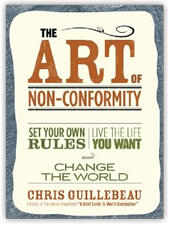My post 4 Ways to Flog the Inner Impulse Shopper is up in Free Money Finance’s March Money Madness tournament. Please take a moment to vote for me(Flog).
Thank you. That is all.
The no-pants guide to spending, saving, and thriving in the real world.
My post 4 Ways to Flog the Inner Impulse Shopper is up in Free Money Finance’s March Money Madness tournament. Please take a moment to vote for me(Flog).
Thank you. That is all.


We grew up in a world of expectations: Eat your vegetables, don’t poop on the carpet, do your homework. It continues right up to “Go to college”, “Get married”, “Having a dozen kids”. Are those the expectations you want to use to guide your life?
Chris Guillebeau, author of The Art of Non-Conformity (the blog and the book) puts the question like this: We we were younger, we heard “If everyone else was jumping off of a cliff, would you do that too?” In theory, that meant we were supposed to think for ourselves. Yet, as adults, we are absolutely expected to conform and do the things everyone else is doing. Work your 40, take a week’s vacation once a year, and repeat until retirement or death.
Is that our only choice?
The Art of Non-Conformity attempts to be a guidebook, showing you how to live the live you want to live. Chris has made a lifelong series of decidedly unconventional choices, from dropping out of high school to attending 3 colleges simultaneously to spending 4 years as a volunteer in Africa. For the past few years, he has been working his way through visiting every country in the world. He is an expert on non-conformity.
The books tells a lot (a LOT) of stories of people who have either made the leap into a self-defined life or people who have done nothing but talk about taking that leap while staying comfortable in their soul-numbing careers.
The Art of Non-Conformity is an inspirational book. It spends a lot of time explaining how to break through the wall of fear to take control of your like. More important, it explains why you’d want to. It does not pretend to define how you should live your life, it just provides the framework for the mentality to help you make that decision for yourself.
If you’re looking for a step-by-step guide, complete with a list of possible work-alternatives, this isn’t the book for you. This book approaches lifestyle design from the conceptual end rather than the practical. If you want a practical manual, I’d get the 4 Hour Workweek by Timothy Ferris. Ideally, you should get both. They complement each other well.
Overall, I thoroughly enjoyed the book. If you’re considering taking a non-standard path or just hate the career- or life-track you are on, you should read The Art of Non-Conformity. I’m planning to read it again in a couple of weeks, just to make sure I absorb all of the lessons.
This is the complete collection of the Story of Sammy. Sammy is a guy I met after my mother-in-law died in the spring of 2012. My wife and I decided to help him launch a….
Read the stories. It’s better that way.
Part 1, in which we meet Sammy, learn of his dreams and offer to help.
Part 2, in which Sammy jumps into business with both feet, teaching teenagers the value of work.
Part 3, in which Sammy shows us what crackheads and the homeless can accomplish if given the chance.
Part 3.5, in which…holy drama, Sammy!
Part 4, in which I am disappointed.

Dispute resolution has to do with the impartial rectification of conflict between individuals or parties. More specifically it is the utilization and execution of methods that are designed to resolve conflicts. In a case in which there is a dispute between people or groups, often times a third, neutral, party is selected to be an impartial representative for the disputing persons. Although dispute resolution can refer to resolutions both in and out of the court, it mainly applies to disputes that are settled outside of the legal framework of the judicial system.
Two of the most common types of dispute resolution are known as adjudicative and consensual. While adjudicative resolution requires a third party to mediate the outcome, such as a judge or jury, and usually involves some form of litigation, consensual resolution is the attempt to solve the issue between the two disputing parties without involving a third party, although at times a neutral arbitrator will be selected to preside over the case, though they will often be there not so much for authoritative purposes but more as a council to keep things fair. There is also a third upcoming type of dispute resolution, online dispute resolution, or ODR, which has become more popular in recent years with the rise of the internet’s prominence in daily life, but it is mainly the application of traditional consensual resolution practices, only adapted to the online environment.
Many disputes can be solved simply through adherence to the law, however, sometimes issues arise that the legal structure isn’t equipped to handle, and so a third party is chosen to resolve the conflict. These types of conflict fall within the jurisdiction of the law and so will be relegated to the political system for arbitration. Judicial resolutions are conflicts that will be, hopefully, settled by the court. In the United States, this is often the case with dispute resolution. This form of resolution usually involves litigation. This is the use of outside individuals to argue for or against the disputing parties. In a courtroom, the lawyers are the litigators, while the judge and jury listen to the arguments in order to come to their decisions.
Extrajudicial resolution is non-court settlement of conflict. Also known as alternative dispute resolution, or ADR, this is what people are usually referring to when discussing dispute resolution. ADR is usually more efficient, cost effective, and less time consuming than judicial resolutions. Extrajudicial resolution concerns various types of ways to settle conflict. These include arbitration and mediation. In arbitration neutral individuals will listen to both sides of an argument and render a decision based on evidence. Unlike the court systems, this proceeding doesn’t necessarily include a binding agreement with the parties.
Mediation is used in extrajudicial resolution as a way to open a dialogue between conflicting parties. The idea is to use a trained neutral third party in order to come up with unique solutions to solve the issue. A mediator is trained to be both an effective negotiator as well as an excellent communicator. A mediator is like a judge in that they cannot take sides, and they do not give legal advice either. Their decisions are not obligatorily followed, though they tend to be followed since the mediators are trained to make decisions that benefit both parties.
The techniques used in dispute resolution can be used both in and outside of the court room. It is often used by individuals who wish to speed up the process by not having to get into the political system. However, they are useful in many cases where individuals wish to come to the most beneficial agreement for all the parties involved.
As of last Monday, we don’t have any tenants in our rental house.

That makes me sad.
It makes me sadder that we were too nice and gave them an extra week free to get their stuff moved out.
Now we get the fun job of painting, replacing the linoleum, and probably cleaning the place up to get it ready for new renters that we haven’t found yet.
New renters.
Ick.
Now, we could put an ad on Craigslist and try to find renters ourselves.
Background checks.
Credit checks.
Interviews and walk-throughs.
Then, when we find someone, we’ll be collecting rent and dealing with any whiny issues that come up.
Yuck.
Or….
We can hire a property manager. The big name property management company in our area charges a $99 set-up fee plus $80 per month.
That covers:
If we add on the tenant-finding service, we’ll be paying them one-month’s rent, but they’ll handle the showings, advertising, background checks, and the lease. And their average tenant placement is 19 days. Another house in the neighborhood that used them had the house rented in about a week.
That moves our landlording firmly into the passive side-hustle category and all it costs us is (essentially) one and a half month’s rent with the added bonus that we’ll be asking the right amount for rent according to the market, instead of guessing. Our last tenants were probably paying $300 too little.
I think the property managers are the way to go, but I have absolutely no experience here.
Have any of you used a property manager? Was it good? Bad? Hell-on-Earth?
Doctor appointments, speeding tickets and too much work. That’s what this week has been made of.

Finance links:
Why do the non-politician folks who want taxes raised think a fund for voluntarily paying extra is stupid? If they were sincere, they’d be contributing to that from the start. As it is, it’s just a demonstration of either hypocrisy or a looting spirit.
Paying off your Visa by charging it on…your other Visa doesn’t accomplish anything for you or for Visa. Even if you are GM and Visa is the federal government.
My wife and I are thinking of starting a potluck/boardgame night. Boardgames are a cheap way to spend a fun evening.
Misc links:
The iFixit Blog. Dedicated to teaching you how to fix your own gadgets.
I am not only a geek, I am a Halloween geek. The Stationery of Horror is full of want.
The Pareto Principle works. Even at work. I get 80% of my value from the time I spend writing blog posts. Err. Nevermind.